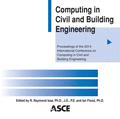Mapping Work Process and Information Exchange of Construction Entities for BIM Implementation: Case Study of an Academic Institute
Publication: Computing in Civil and Building Engineering (2014)
Abstract
Building Information Modeling (BIM) represents modern construction management concepts that can be integrated in every phase throughout the facility lifecycle. Not only can BIM enhance the performance and efficacy of the construction project delivery process, but it can also improve the quality of the delivered products and reduce various forms of project waste. The principal concept of BIM is the collaboration among all stakeholders in different phases of the facility lifecycle to manage relevant information efficiently. However, this data sharing concept is extremely challenging for the construction industry where the project delivery process is unstructured and fragmented. Thus, the primary step for implementing BIM in any construction entity is to assimilate current organizational conditions, especially its work processes and information exchange. This paper investigates the work process and information exchange in construction projects by focusing on the project owner. The Office of Physical Resources Management (OPRM) at Chulalongkorn University (Thailand), which is responsible for developing the university's construction projects, was chosen as a case study to illustrate an application of the proposed methodology. General information about the OPRM as it relates to facility design and construction was first gathered, including organizational structure, the stakeholders involved, their roles and responsibilities, and current information exchange. The phases of a construction project were defined by adapting from those in the OmniClass Construction Classification System (OCCS), which is used widely in the construction industry. The collected information was analyzed and organized to map important work processes and information exchanges among the stakeholders throughout the project lifecycle. Due to the complexity of workflows, the Business Process Model and Notation (BPMN) was adopted to illustrate and communicate the results. A key feature of the BMPN is the formal documentation of information exchange requirements among the stakeholders in terms of paper and electronic documents. The results of this formal mapping has proven instrumental in helping all parties, especially project owners, comprehend the project delivery process thoroughly so that the appropriate elements can be modified to support and accommodate the transition to BIM implementation.
Get full access to this article
View all available purchase options and get full access to this chapter.
Information & Authors
Information
Published In
Copyright
© 2014 American Society of Civil Engineers.
History
Published online: Jun 17, 2014
Authors
Metrics & Citations
Metrics
Citations
Download citation
If you have the appropriate software installed, you can download article citation data to the citation manager of your choice. Simply select your manager software from the list below and click Download.
